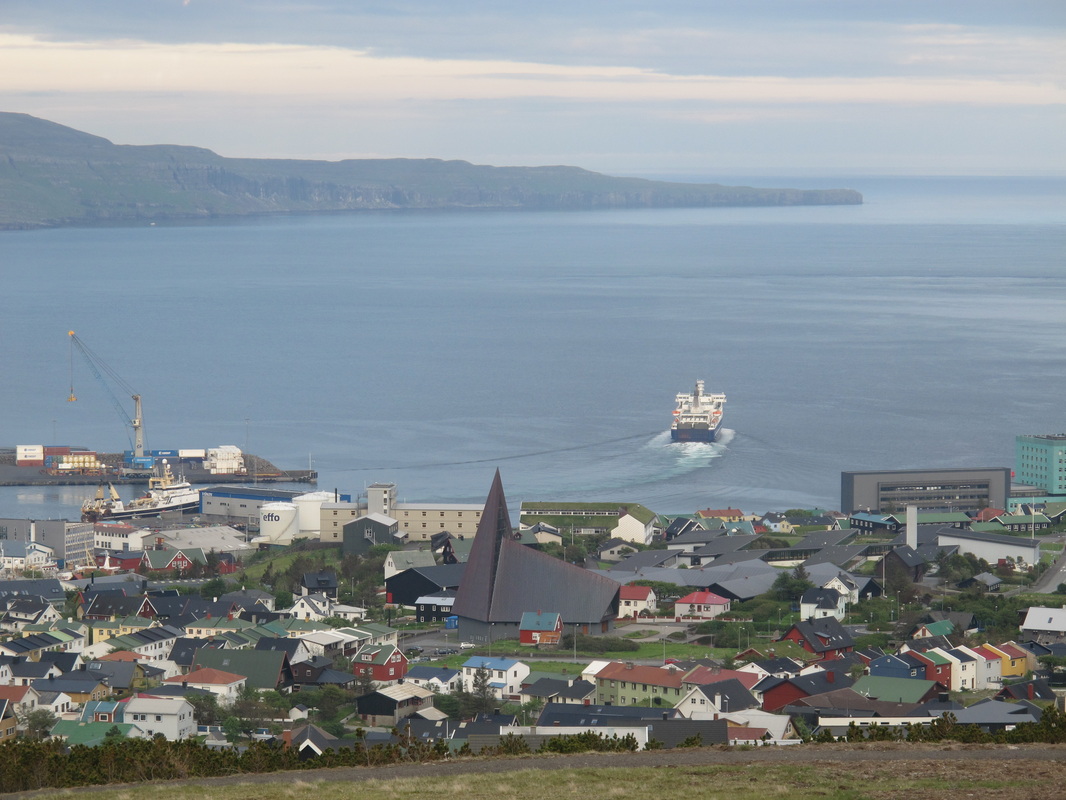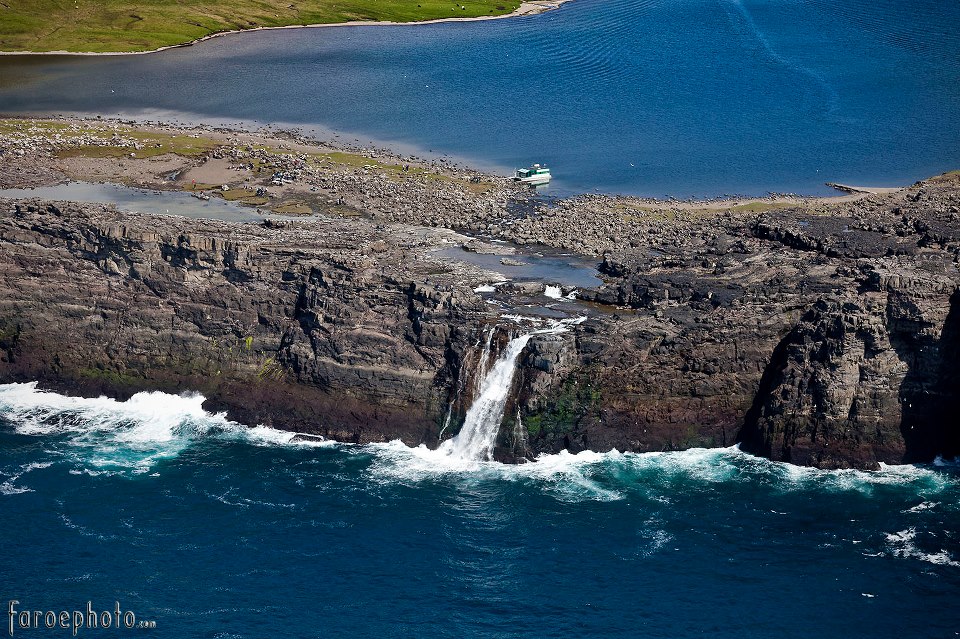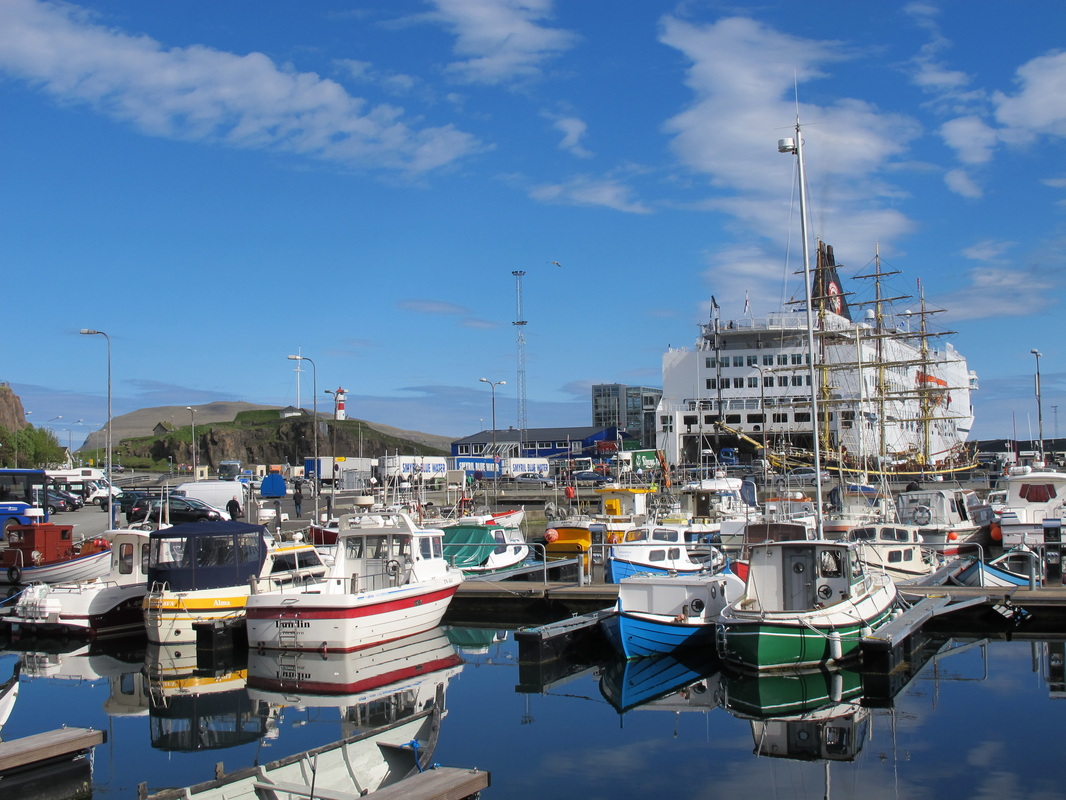The main airport is on Vagar, a separate island from Streymoy which holds the capital Torshavn. The picture above was taken at about 10.30pm on the June week I visited last year. It's light late in summer in the North. The Faroes are 200 miles north of mainland Scotland, 280 miles south east of Iceland and 480 miles west of Norway.
In World War II its strategic position controlling access into the North Atlantic led to its occupation by the British.
The airport you land at on Vagar island was was built by British forces.
It's sited between mountains over the largest fresh water lake in the island which almost - as if imagined by Tolkien - runs right up to a cliff above the sea and then melodramatically overflows over the edge in a waterfall.
It's a good introduction - as you fly past the lake and the waterfall - to the unhinged landscape of the Faroes and its Maritime Subartic climate.
We careened over bridges and through tunnels amidst a bare almost primeval landscape of huge sounds between islands and mountains with rocky caps. John and I talked demographics.
The driver was a bull of man, proud of being Faroese, who was so big he found it hard to fit in his seat - let's call him John because I've forgotten his name.
We were sharing the cab with a Scots couple in their sixties. Nice people. They'd come for the bird-watching. The Faroes is grand for that. Birds love the islands like sun worshippers love Balearics. And where the birds go people with binoculars aren't far behind. A harmless and peaceful bunch those twitchers.
John the taxi-driver was the same as taxi-drivers the world over: direct to the point of bluntness but still an insight into how a nation and a people work.
As we drove away from the airport we passed the lake pictured above and John said as we passed a turn off, "This is where people park before heading to jump off the rocks at the end of the lake above the sea. Problem is it's not so far down the cliff so they sometime miss killing themselves. You can see them now and then dragging themselves back up here to drive home again."
John paused and with a smile said, "A bit wiser, maybe." And then another laugh. "Then they go home and have dinner with their families, say it was a quiet day. Who knows?"
Later as we passed some sheep, I asked, "Do you eat a lot of local lamb and fish?"
"No we export it mainly. It's easier to import the food from Denmark." The Faroes are a self-governing country under the sovereignty of the Danish crown. So much for local sourcing in the 21st century.
We careened over bridges and through tunnels amidst a bare almost primeval landscape of huge sounds between islands and mountains with rocky caps.
John and I talked demographics. I wondered about the claim in the tourist brochure that over 20 languages are spoken in the Faroe Islands. Since this is a very remote North Atlantic archipelago with a population of 49,000, many of whom live in Torshavn (18,000) I found it hard to credit.
"My wife is Kenyan," said John.
"Really, did you meet her because she came for work?" I said.
John turned from the wheel and looked at me, seemingly driving for half a mile along a cliff edge without looking at the road.
"Now why would a black woman from Africa be working here?" he laughed. "It's not easy to get to as you've found."
"So how did you meet?" I asked.
"I met her on an internet dating site and invited her over. That's one of the reasons there are so many languages now. Lot's of internet brides and girlfriends. Perhaps there's only one person speaking that language but I suppose it counts when the tourist people write their things."
Later on the trip I would see a couple of Thai ladies, the odd Vietnamese, a Nigerian woman. In fact there were numbers of women from across the world.
Now within the legislature of the laws of unforeseen outcomes who'd have thought the digital age would lead to demographic revolution. Within a tiny population such as the Faroes these internet brides and girlfriends, who all seem to have kids, are changing the mono-culture of the islands.
Give it a few years and these lonely rocks in the North Atlantic might have one of the most diverse populations around, all because the internet opens a communication bridge between a windswept hillside in Streymoy and the packed suburbs of Nairobi.
As we got to Torshavn, John laid down another slab of dry wit.
"This is Main Street," he said. "One, two, three, four, five, now it's finished. It's a five second street for driving along."
Torshavn was tiny, unspectacularly pretty, especially close to the harbour. The hotel was efficient but old fashioned. Over dinner I kept smiling at the taxi-driver's words. Tour guides, informal or formal, come in many guises and sometimes their unstudied insights into locations are worth several tons of official tourist literature.
I stopped smiling and giggling to myself when I realised as I was on a press trip solo. Other people in the restaurant were wondering whether I was an axe-killer taking his final meal before taking terrible revenge on the innocent for his perceived grievances.
Or maybe they thought I was a bird-watcher who'd spotted that day the rare albino puffin and was feeling smug.



 RSS Feed
RSS Feed